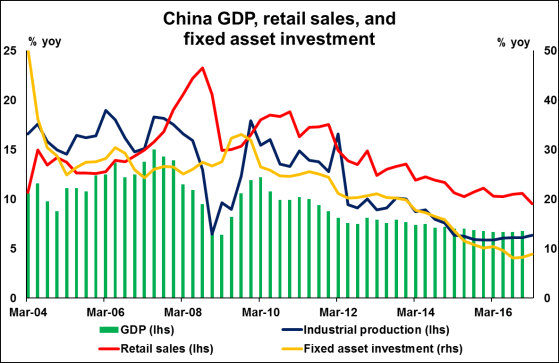Next week’s market movers
- In Turkey, citizens will head to the polls to decide whether to grant their government additional powers. The outcome could have a notable impact on the Turkish lira.
- In New Zealand, CPI data for Q1 are expected to show inflation returning to the midpoint of the RBNZ’s target range, which could greatly diminish the likelihood for any further easing.
- From Australia, we get the minutes from the latest RBA meeting, where the Bank remained on hold and shifted to a somewhat more dovish tone.
- We also get key economic data from Eurozone, the UK, China, and Canada.
Major events begin early next week. On Sunday, Turkish citizens will head to the polls to vote on constitutional changes that could greatly expand the executive powers of President Erdogan. The referendum will ask the question of whether to turn Turkey from a parliamentary to a presidential republic. The government and the President argue that a "yes" vote would reduce political deadlocks, thereby accelerating the pace of future reforms. On the other hand, critics of these changes argue that too much power would be concentrated in the hands of one person, which could increase the risk for an authoritarian government in the future. Opinion polls suggest that this race is too close to call. A "yes" outcome is seen by most polls as being more likely, but marginally so. Importantly, the majority of polls show a high percentage of undecided voters, so surprises are definitely possible.
With regards to the Turkish lira, we see the case for the currency to strengthen under a "yes" outcome, and to weaken if the Turkish public votes against these reforms. Ever since the failed military coup last year, Turkey has remained in a state of emergency, which is still ongoing. Media reports suggest that in a "yes" scenario, the government could lift this state of emergency, which in our view could prove positive for the lira in the short-term, as some political uncertainty dissipates. On the other hand, a "no" vote could heighten political uncertainty even further. The state of emergency could stay in place, and there seems to be no clear plan about what happens next. Some reports suggest that the nation could even go into early elections as soon as this year.
On Monday, markets will remain closed in most G10 nations, in celebration of Easter Monday
Nevertheless, during the Asian morning, we will get China’s GDP data for Q1. Expectations are for the Chinese economy to have grown at the same pace as previously. We see the risks surrounding that forecast as tilted somewhat to the downside. Our view is based on the nation’s trade data for the quarter, where imports skyrocketed throughout Q1, whereas exports only began to pick up in March. This may have weighed on net exports and thereby, GDP growth. The fact that yearly retail sales have slowed notably in January and February compared to those same months in 2016, enhances this view. We also get the nation’s industrial production, fixed asset investment and retail sales, all for March. Retail sales are expected to have accelerated slightly, industrial production is forecast to have risen at the same pace as previously, while fixed asset investment is expected to have slowed somewhat.

On Tuesday, during the Asian day, the RBA will release the minutes from its April policy meeting, where the Bank remained on hold, and shifted to a somewhat more dovish tone. Policymakers indicated that some labor market indicators have softened recently, while they noted that the recently announced supervisory measures with regards to lending could ease financial stability risks. At the time, this suggested to us that once these measures take effect, the Bank would be more flexible to cut rates again if needed, without being concerned that its actions would amplify risks to the economy. We will examine the minutes for any clues on how concerned the Bank was regarding the labor market, and whether the officials would indeed cut rates without much hesitation in case the outlook deteriorates. Having said that though, following the remarkable jobs report for Marc, released after that meeting, we think that the probability for any further RBA easing is pretty low. We think this is also likely to be reflected in the Bank’s tone at the next policy meeting.
On Wednesday, we have a relatively quiet day, with no major events or indicators due to be released.
On Thursday, during the Asian morning, we get New Zealand’s CPI data for Q1. The forecast is for the CPI rate to have surged to +2.0% yoy from +1.3% yoy in Q4. We think that such an acceleration is likely to be very encouraging for RBNZ policymakers, as it would bring the rate exactly in line with the midpoint of the Bank’s target range. At its latest gathering, the Bank kept the door open for further easing, and noted that it expects inflation to return to the midpoint over the "medium-term". As such, we think that a sooner-than-expected return to that point is likely to diminish the likelihood for any further rate cuts by the RBNZ and may even lead policymakers to close the door for any further easing. This view is amplified by the fact that the nation’s 2-year inflation expectations have risen recently, and are now almost in line with that midpoint as well.

On Friday, we get the preliminary Markit manufacturing and services PMIs for April from several European nations and the Eurozone as a whole. Most of these indices are expected to tick down, but to remain at very healthy levels. Even though these are likely to be more pleasant news for ECB policymakers, we think that they are unlikely to lead to a material change in the Bank’s dovish rhetoric, at least not at the upcoming meeting in late April. The ECB has made it absolutely clear that it is too early to discuss any reduction in stimulus and thus, despite the continued strength in forward-looking indicators such as the PMIs. The case for the Bank to remain dovish for a while is enhanced by the latest pullback in the bloc’s core CPI rate, as well as the looming elections in France, which could trigger a surge in the bloc’s government bond yields.

In the UK, retail sales data for March are coming out. The forecast is for sales to have fallen somewhat from the previous month. The case for a decline in sales is supported by the nation’s consumer sentiment indices for the month. The TR/IPSOS figure declined while the Gfk index remained unchanged within the negative area. What’s more, the BRC retail sales monitor for the month declined as well. Moving forward, we think that retail sales are likely to play a key role regarding how BoE policy evolves. The Bank has repeatedly stressed that it expects a slowdown in demand this year, as a consequence of lower real income growth. A considerable slowdown in retail sales over coming months could confirm the Bank’s concerns and thereby, eliminate any surviving speculation regarding a tightening move in the foreseeable future.

From Canada, we get CPI data for March. The forecast is for the headline rate to have declined somewhat, while no forecast is available for the core rate. The case for a pullback in the headline rate is supported by the yearly change of oil prices, as well as the latest BoC meeting statement, which indicated that the Bank expects CPI inflation to dip in the months ahead as some temporary factors unwind. As for the core rate, our own view is that it may have remained unchanged. We base this hypothesis on the nation’s Markit manufacturing PMI for the month, which indicated that manufacturers raised the prices on final products at the steepest rate for three years. So, although temporary factors may have dragged down the headline rate, the core rate may have held firm, we think.














